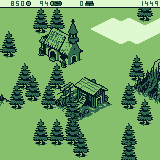I have been working with so called fantasy consoles for about 4 years. I have already written about my experience using wasm4 here. Fantasy console are basically programming/execution environments with a set of usually quite restrictive constraints (e.g. limited resolution, input methods, memory etc.). These really help with creativity and producing an actual result, instead of bike shedding and never actually producing anything.
WASM-4
My favorite platform up until last year was WASM-4. It allows you to use compiled languages (as long as they target wasm) and has even basic online multiplayer support. Unfortunately support for the Go version has been quite bad in recent releases. They have been relying on tinygo, but problems with memory management are still present. Maybe with upcoming wasm support from go itself these problems will go away (though I would be worried about the resulting cart size), but for now they remain.
It also has no inbuilt tooling like a text editor, sprite editor or sound editor (though there are third party carts for the latter). That means you can use your already existing favorite tooling, but it also means it is a less integrated workflow than e.g. Pico8.
Being limited to 4 colors is also quite restrictive and makes the import of sprites a bit tedious (they are basically converted into byte arrays of the host language). Since one color is used for transparency you are limited to 3 colors per sprite. That is just not enough for a lot of games.
My last game for WASM-4 was an Anno 1602 demake which used pushed the limits of the WASM-4 color “space”. But working around the memory problems and restriction (64kb) was a bit tedious and was costing motivation. I didn’t really added any music, but that basic game play loop was close to finished.


Generative AI
For this last game I was also using generative AI for the first time (on the topic of game development that is). On two fronts the use was quite successful.
Sprite Creation
All sprites in the game are AI generated (with the exception of the resources in the header). They are generated with a SD 1.5 base model tuned for pixel art. The result gets down sampled 8 times and color corrected via a web ui extension. I used txt2img and img2img for most attempts. Most sprites needed about 50-100 generated images until I got something usable. The result was converted into a 4 color indexed png using my own little tool. Finally I did some cleaning up in aseprite.
Island Generation
I was looking for an algorithm to create islands and I used deepseek and chatgpt. Deepseek produced a nice looking well commented algorithm that ultimately did not really produce a useful output. Chatgpt (o1) on the other hand produced a great result even though the code itself did not look to appealing. I changed the result to use a memory conserving bitset. See the result in the linked repository. These are both one shot results so quite impressive I would say.
Pico8 and Picotron
The future of my endeavour in game development will probably take place in Pico8 and Picotron. While Pico8 was a pioneer in the fantasy console world and has a great community, Picotron on the other hand is more of a workstation with some softened restraints to create bigger games with even better integrated tooling.
I will stick with Go as my main programming language for bigger games (probably using ebitengine as my favorite engine).
I may return to WASM-4 once they fixed their go implementation, but not for now.